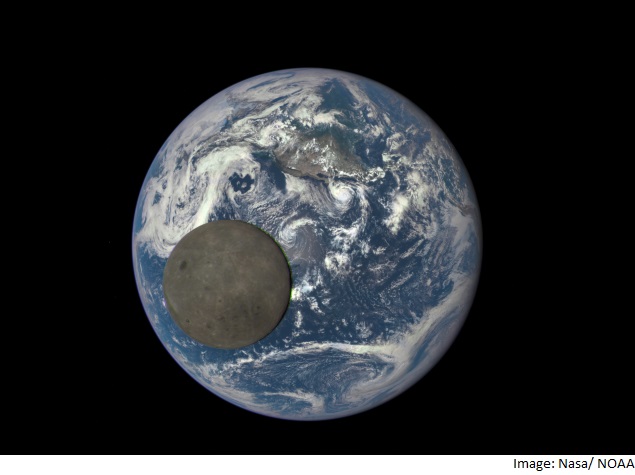- Home
- Science
- Science News
- Nasa Camera Shows Moon Passing in Front of the Earth
Nasa Camera Shows Moon Passing in Front of the Earth

From nearly 1.6 lakh km away, a Nasa camera has captured a stunning view of the far side of the moon as it moved in front of the sun-lit side of Earth last month.
The images show the fully illuminated "dark side" of the moon that is never visible from Earth.
The lunar far side lacks the large and dark basaltic plains (called maria) that are so prominent on the Earth-facing side.
A thin sliver of shadowed area of moon is visible on its right side.
"It is surprising how much brighter Earth is than the moon. Our planet is a truly brilliant object in dark space compared to the lunar surface," said Adam Szabo, project scientist at Nasa's Goddard Space Flight Center in Greenbelt, Maryland.
The images were captured by Nasa's Earth Polychromatic Imaging Camera (EPIC), a four megapixel CCD camera and telescope aboard the Deep Space Climate Observatory (DSCOVR) satellite orbiting 1 million miles (1.6 lakh km) from Earth.
EPIC maintains a constant view of the fully-illuminated Earth as it rotates, providing scientific observations of ozone, vegetation, cloud height and aerosols in the atmosphere.
The far side of the moon was not seen until 1959 when the Soviet Luna 3 spacecraft returned the first images.
Since then, several Nasa missions have imaged the lunar far side in great detail.
The same side of the moon always faces an earthbound observer because the moon is tidally locked to Earth.
That means its orbital period is the same as its rotation around its axis.
Once EPIC begins regular observations next month, Nasa will post daily colour images of Earth to a dedicated public website.
About twice a year, the camera will capture the moon and Earth together as the orbit of DSCOVR crosses the orbital plane of the moon.
Get your daily dose of tech news, reviews, and insights, in under 80 characters on Gadgets 360 Turbo. Connect with fellow tech lovers on our Forum. Follow us on X, Facebook, WhatsApp, Threads and Google News for instant updates. Catch all the action on our YouTube channel.
Related Stories
- Samsung Galaxy Unpacked 2025
- ChatGPT
- Redmi Note 14 Pro+
- iPhone 16
- Apple Vision Pro
- Oneplus 12
- OnePlus Nord CE 3 Lite 5G
- iPhone 13
- Xiaomi 14 Pro
- Oppo Find N3
- Tecno Spark Go (2023)
- Realme V30
- Best Phones Under 25000
- Samsung Galaxy S24 Series
- Cryptocurrency
- iQoo 12
- Samsung Galaxy S24 Ultra
- Giottus
- Samsung Galaxy Z Flip 5
- Apple 'Scary Fast'
- Housefull 5
- GoPro Hero 12 Black Review
- Invincible Season 2
- JioGlass
- HD Ready TV
- Laptop Under 50000
- Smartwatch Under 10000
- Latest Mobile Phones
- Compare Phones
- Realme P4x 5G
- OnePlus Ace 6T
- OPPO A6x 5G
- Samsung Galaxy Z TriFold
- Poco F8 Ultra
- Poco F8 Pro
- Huawei Mate 80 RS Master Edition
- Huawei Mate 80 Pro Max
- Asus ProArt P16
- MacBook Pro 14-inch (M5, 2025)
- Poco Pad M1
- Poco Pad X1
- Just Corseca Skywatch Pro
- Honor Watch X5
- Acerpure Nitro Z Series 100-inch QLED TV
- Samsung 43 Inch LED Ultra HD (4K) Smart TV (UA43UE81AFULXL)
- Asus ROG Ally
- Nintendo Switch Lite
- Haier 1.6 Ton 5 Star Inverter Split AC (HSU19G-MZAID5BN-INV)
- Haier 1.6 Ton 5 Star Inverter Split AC (HSU19G-MZAIM5BN-INV)

















